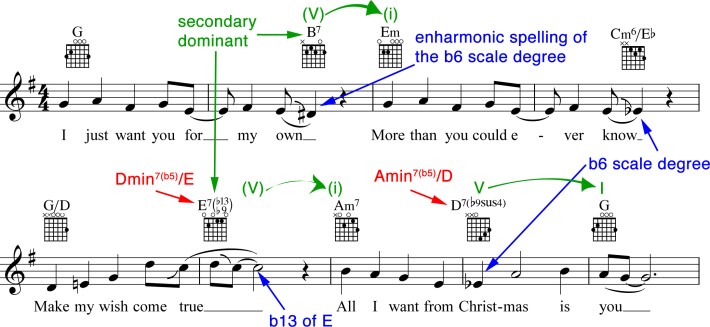Brace yourself.It's that time of year, which means Mariah Carey's enduringly popular Christmas tune is back in your life, either by invitation or not. Unquestionably, this 1994 song has joined the time-honored canon of Christmas standards, alongside classics like Mel Torme's "The Christmas Song" (1945) and Vince Guaraldi's "Christmas Time is Here" (1965).In fact, Billboard now ranks Mariah Carey's "All I Want For Christmas Is You" as the #1 holiday song of all time — and as of this week it's the #1 song in America for the fourth straight December.Stereogum's Chris DeVille once rhetorically asked if this song is the only true Christmas standard to have been written in the last 30 years. I believe the answer is "yes."Why has this particular song managed to achieve such status?Let's figure it out.
When writing "All I Want For Christmas Is You," Mariah Carey and her collaborator, Walter Afanasieff, did something unusual: They eschewed the prevailing impulse to restrict the song's architecture to simple triads (three-note chords) and diatonic melodies (using only notes from the song's key signature) — which are the basic building blocks of most modern pop music.Instead, they employed compositional elements of classic songs from the mid-20th Century — elements we rarely hear in the pop music written during the last three decades, Christmas or otherwise.These elements are steeped in 1940s jazz vocabulary and 19th Century European Romanticism, so they subtly conjure a bygone era. And therein lies the crucial factor. The harmony in "All I Want For Christmas" invokes the main ingredient that makes those Christmas standards "feel" like Christmas: nostalgia.
A Nostalgic Cadence
We use the term "cadence" to describe how a musical phrase resolves. In European classical music, the most common resolution is the "authentic" V-to-I cadence (listen to almost anything by Mozart or Haydn.) Another kind of cadence, the "plagal" cadence (sometimes called the "amen cadence" due to its frequent setting to the text "amen" in church hymns) is a IV-to-I resolution.It's a more gentle-sounding cadence, and you can hear a great example of it in the Beatles' "Yesterday" (the two chords that finish the line, "Oh, I believe in yesterday").
A variation of the IV-to-I plagal cadence is the "minor plagal cadence," which engages the minor iv chord to resolve to the I chord. One particularly poignant way to execute this maneuver is with a IV-iv-I resolution (i.e., Major IV to minor iv to I).See Figure 1 below.

The movement from the notes E to E♭ to D creates a chromatic line for smooth voice leading, as lowering the 6th scale degree to the ♭6 brings it closer to the 5th scale degree resolution note through a process called "chromatic intensification," imbuing it with a stronger sense of pull. Notably, this cadence provides an example of what we call "modal interchange," where we borrow a chord from the parallel minor scale: C minor is the "iv" chord in the key of G minor. Songwriters of the Tin Pan Alley era used this cadence regularly to summon a wistful feeling, as the bittersweet ♭6 scale degree yearns to resolve down to the comforting 5th scale degree.(Irving Berlin's 1942 classic "White Christmas" is a fitting example.)Decades — perhaps centuries — of hearing this harmonic movement have trained us as listeners to experience this sound as "sentimental" — and it is precisely this characteristic that "All I Want For Christmas Is You" exploits to invoke the feeling of nostalgia. See Figure 2 below.

Nostalgic Inversions
Carey and Afanasieff used an especially tasty flavor of the iv chord in their minor plagal cadence by emphasizing the ♭6 scale degree (making it the bass note) and by adding the note "A" in both the melody and in the harmony, turning it into a Cmin6/E♭.(Alternatively, we could call it an E♭6(b5) chord — but it's easier to understand it as a Cmin6 in 1st inversion.)The Cmin6 chord possesses a kind of contemplative dissonance relative to the plain Cmin, and I totally get why Carey and Afanasieff used it here. Minor-6 chords have a kind of moody complexity and can sound riveting given the right context. This is because the minor-6 chord is actually an inversion of the minor-7-flat-5 ("min7(♭5)") or half-diminished — a chord that can sound exquisitely heartbreaking in a tension-and-release harmonic passage. The root-and-♭5 combination of the min7(♭5) chord (or ♭3-and-6 combination of the min6 chord) produces a "tritone" interval — an unstable and dissonant mixture that desperately craves resolution. See Figure 3 below.

With most four-note chords, if you were to alter the order of how the notes are stacked vertically from top to bottom, you might find that it doesn't affect the musical outcome that much. But this isn't so with the min6 and min7(♭5) inversions.What's so alluring about these four-note chords is that they can take on a different emotional meaning based on how they're voiced and depending on what chord comes next. Listen to the jazz standard "Autumn Leaves" — and pay attention to the line "but I miss you most of all, my darling." The Emin7(♭5) functions as a substitute for the ii chord in a quasi ii-V-i cadence, producing a divinely aching or longing feeling. You'll find similar — as well as divergent — dramatic effects in jazz standards like "Stella By Starlight," with the results varying depending on the harmonic motion preceding and following each min7(♭5) chord.5
With "All I Want For Christmas Is You," the minor plagal cadence in the verse imparts a restrained sense of nostalgia and yearning — not an overwrought one — because the particular Cmin6/E♭ voicing Carey and Afanasieff used doesn't deliver the concentrated sentimentality of a chord voiced from the bottom up as an Amin7(♭5).I guess you could say they calibrated the nostalgia level so as to not make the song too treacly. Moreover, the song's overall vibe is quite joyous — not at all maudlin. Apart from the harmony, we can attribute the lively feel to the song's other crucial nostalgic element. That element, of course, is its production style, which invokes another blast from the past: the '60s Brill Building pop sound.
Wall-of-Nostalgia
Walter Afanasieff has described how he and Mariah Carey set out to invoke the '60s girl-group "Wall of Sound," specifically as heard on Phil Spector's 1963 album, A Christmas Gift For You.6 More precisely, they intended to channel one particular song: Darlene Love's "Christmas (Baby Please Come Home)."7
It's difficult to miss the stylistic connections between Phil Spector's production and Afanasieff's on "All I Want For Christmas Is You." Both songs contain an eighth-note triplet rhythmic figure forming a peppy shuffle groove. The Darlene Love recording swings a bit harder than Mariah's, as it has a slower tempo (hovering around 128 bpm, allowing for the 3rd note of each eighth-note triplet grouping to lag slightly, producing a hipper feel) and the rhythm section features live world-class musicians. (The Wrecking Crew knew how to swing.) I clocked "All I Want For Christmas Is You" at a fixed 150.16 bpm, and Afanasieff programmed the rhythm section with a MIDI sequencer — so the result is a stiffer-sounding performance. Nevertheless, the nostalgia-soaked '60s Phil Spector vibe is quite apparent, particularly in the background vocals, hand claps, timpani, and piano gestures.
Another curious connection is each song's use of an iconic four-chord progression. Darlene Love's "Christmas (Baby Please Come Home)" is built almost completely around a I-iii-IV-V progression. Mariah Carey's song uses the '50s doo-wop I-vi-IV-V progression in a more limited (albeit recurring) role, following each chorus. The difference is in the second chord (the iii versus the vi), although functionally they're quite similar. The iii chord and the vi chord both have what we call "tonic function," and in these sequences their job is to "prolongate" the I chord. (Harmonic prolongation is a concept from Shenkerian analysis — a fascinating topic, but perhaps one for another article.)
Harmonic Nostalgia Continues
Unsurprisingly, the prechorus/chorus section of "All I Want For Christmas Is You" is where things really heat up. Mariah Carey's melody features nice use of chromaticism and elegant intervallic jumps. The harmony uses a secondary dominant chord and cleverly disguised min7(♭5) chords to fashion cascading V-I (and V-i) authentic cadences. See Figure 4 below.

The lines "I just want you for my own" and "more than you could ever know" both use the exact same melodic pitches and rhythms, but each phrase produces a slightly different dramaturgical effect due to the shifting harmony underpinning it. Remember that the diatonic chord built on the third scale degree of G Major is Bmin7 (comprising the notes B, D, F#, A) — but on the word "own," Afanasieff has raised the D to D#, which accommodates the wistful ♭6 note (enharmonically spelled D#) that Mariah sings in the melody. He has altered the iii chord to create a leading tone relationship that pulls us into the next chord, Emin. In effect, the B7 functions as a secondary dominant that "tonicizes" the vi chord, temporarily making Emin the center of gravity. We can hear a great example of this exact maneuver in Hoagy Carmichael's "Georgia On My Mind," as performed by Ray Charles.Check out the first three bars in the opening chorus. The same three-chord sequence (G, B7, Emin) truly invokes a feeling of longing (in keeping with that song's lyrics).
https://youtube.com/watch?v=fRgWBN8yt_E /wp:paragraph -->






